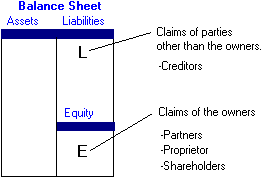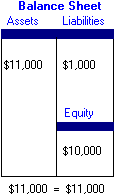Balance Sheet Format
Certain rules determine how the balance sheet items are listed. On the assets side, Cash is usually listed first. (Cash includes all the money owned by the entity, whether in a cash drawer or in a bank account.) The other assets are listed in the order of their nearness to cash, that is, how soon they are likely to be turned into cash. Inventory, for example, is likely to be sold sooner than the entity's furniture. As you add asset items, keep this rule in mind.
The right-hand side is divided into two main sections. One is called liabilities and the other equity. From here on, the name used for the heading of these two sections is Liabilities and Equity.

Liabilities are claims of parties other than the owners against assets. The order in which liabilities are listed corresponds to how soon each must be paid.
In a profit-oriented entity, the equity section shows the claims of the owners. These are the shareholders in a corporation, the partners in a partnership, and the proprietor of a one-owner entity. In a nonprofit entity, the equity section is the interest of the entity itself: the residual amount after the liabilities have been satisfied. Since the owners cannot claim assets until after the claims of outside parties have been satisfied, the equity section is listed below the liabilities.

Rather than listing the two sides of the balance sheet side by side, programs often list the assets section before the liabilities and equity section. This is done because the names of some items are too long to fit in a side-by-side format. Thus, the computer would print the balance sheet you developed in the preceding section as follows:

Because the right-hand side of the balance sheet is divided into two main sections, the fundamental accounting equation is often stated as:
ASSETS = LIABILITIES + EQUITY
